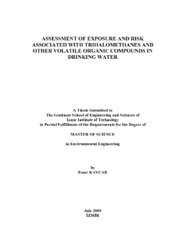Please use this identifier to cite or link to this item:
https://hdl.handle.net/11147/3270Full metadata record
| DC Field | Value | Language |
|---|---|---|
| dc.contributor.advisor | Sofuoğlu, Sait Cemil | - |
| dc.contributor.author | Kavcar, Pınar | - |
| dc.date.accessioned | 2014-07-22T13:51:12Z | - |
| dc.date.available | 2014-07-22T13:51:12Z | - |
| dc.date.issued | 2005 | - |
| dc.identifier.uri | http://hdl.handle.net/11147/3270 | - |
| dc.description | Thesis (Master)--Izmir Institute of Technology, Environmental Engineering, Izmir, 2005 | en_US |
| dc.description | Includes bibliographical references (leaves: 64-70) | en_US |
| dc.description | Text in English; Abstract: Turkish and English | en_US |
| dc.description | x, 81 leaves | en_US |
| dc.description.abstract | Concentrations of 54 volatile organic compounds (VOCs) were measured in İzmir drinking water, and associated health risks due to ingestion of these compounds were investigated using a semi-probabilistic sampling design. 100 houses were visited in different districts of İzmir and drinking water samples were collected from consumer taps and bottled waters. Using questionnaires, demographics and drinking water consumption rates were determined. Individual and population based exposures and risks were estimated by employing deterministic and probabilistic approaches, respectively.Trihalomethanes (THMs) (i.e., chloroform, bromodichloromethane, dibromochloromethane, and bromoform), benzene, toluene, p-xylene, and naphthalene were the most frequently detected VOCs in İzmir drinking water with concentrations ranging from below detection limit to 35 .g/l. None of the samples exceeded the maximum contaminant levels stated in the Turkish, European, and American drinking water regulations. For all VOCs, the concentrations measured in metropolitan area were greater than those in other districts. All THM species were detected in higher concentrations in tap water.Noncarcinogenic risks attributable to ingestion of VOCs in İzmir drinking water were negligible whereas the mean carcinogenic risk estimates for bromodichloromethane and dibromochloromethane were above the acceptable level of one in a million (10-6). Deterministic approach revealed that 23%, 29%, and 2% of individuals had lifetime cancer risks greater than 10-6 associated with ingestion of bromodichloromethane, dibromochloromethane, and bromoform, respectively. The results of this study show that exposures to drinking water contaminants and associated risks may be higher than the acceptable level even if the concentrations fall below the drinking water standards. | en_US |
| dc.language.iso | en | en_US |
| dc.publisher | Izmir Institute of Technology | en_US |
| dc.rights | info:eu-repo/semantics/openAccess | en_US |
| dc.subject.lcc | TD312.I9 .K21 2005 | en |
| dc.subject.lcsh | Drinking water--Turkey--İzmir | en |
| dc.subject.lcsh | Drinking water--Health aspects | en |
| dc.subject.lcsh | Drinking water--Contamination--Health aspects | en |
| dc.subject.lcsh | Drinking water--Standards | en |
| dc.subject.lcsh | Water quality | en |
| dc.title | Assessmanet of Exposure and Risk Associated With Trihalomethanes and Other Volatile Organic Compounds in Drinking Water | en_US |
| dc.type | Master Thesis | en_US |
| dc.institutionauthor | Kavcar, Pınar | - |
| dc.department | Thesis (Master)--İzmir Institute of Technology, Environmental Engineering | en_US |
| dc.relation.publicationcategory | Tez | en_US |
| dc.identifier.wosquality | N/A | - |
| dc.identifier.scopusquality | N/A | - |
| item.grantfulltext | open | - |
| item.openairecristype | http://purl.org/coar/resource_type/c_18cf | - |
| item.fulltext | With Fulltext | - |
| item.cerifentitytype | Publications | - |
| item.languageiso639-1 | en | - |
| item.openairetype | Master Thesis | - |
| Appears in Collections: | Master Degree / Yüksek Lisans Tezleri Sürdürülebilir Yeşil Kampüs Koleksiyonu / Sustainable Green Campus Collection | |
Files in This Item:
| File | Description | Size | Format | |
|---|---|---|---|---|
| T000375.pdf | MasterThesis | 556.2 kB | Adobe PDF |  View/Open |
CORE Recommender
Page view(s)
396
checked on Jul 7, 2025
Download(s)
106
checked on Jul 7, 2025
Google ScholarTM
Check
Items in GCRIS Repository are protected by copyright, with all rights reserved, unless otherwise indicated.